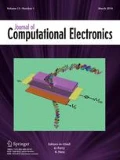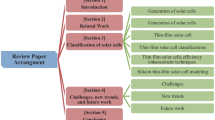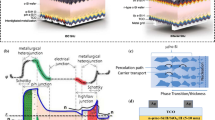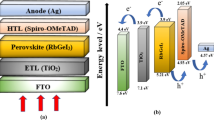Abstract
Optoelectronic two dimensional technology computer aided design simulation of unconstrained four terminal hydrogenated amorphous silicon/crystalline silicon (a-Si:H/c-Si) tandem solar cells have been carried out. Tandem solar cell approach is one of the promising approaches to achieve high efficiency solar cell by reducing lattice thermalization loss, but needs extensive optimization as the efficiency depends on a number of parameters. The optoelectronic properties of various materials involved have been taken into consideration and a range of parameters such as top anti reflection coating (ARC) thickness, bottom ARC thickness, a-Si:H solar cell thickness, optical connecting layer thickness, a-Si:H solar cell doping, crystalline silicon solar cells doping etc. have been optimized. The optimization resulted in a simulated efficiency of 19.29 % for an untextured planar solar cell.










Similar content being viewed by others
References
Green, M.A., Emery, K., Hishikawa, Y., Warta, W., Dunlop, E.D.: Solar cell efficiency tables (version 44). Prog. Photovolt. Res. Appl. 22(7), 701–710 (2014). doi:10.1002/pip.2525
Green, M.A.: The path to 25 % silicon solar cell efficiency: history of silicon cell evolution. Prog. Photovolt. Res. Appl. 17(3), 183–189 (2009). doi:10.1002/pip.892
Atlas User’s Manual: Device Simulation Software. Silvaco Int., Santa Clara, CA (2008)
Shaw, J.G., Hack, M.: An analytic model for calculating trapped charge in amorphous silicon. J. Appl. Phys. 64(9), 4562 (1988). doi:10.1063/1.341258
Yamamoto, K., Nakajima, A., Yoshimi, M., Sawada, T., Fukuda, S., Suezaki, T., Ichikawa, M., Koi, Y., Goto, M., Meguro, T., Matsuda, T., Kondo, M., Sasaki, T., Tawada, Y.: A high efficiency thin film silicon solar cell and module. Sol. Energy 77(6), 939–949 (2004). doi:10.1016/j.solener.2004.08.028
Tokyo Electron Ltd.: New record-breaking PV module efficiency has been achieved. http://www.mechatronics.tel.com/en/media/press-releases/details/news/2014/07/09/new-record-breaking-pv-module-efficiency-has-been-achieved/ (2014). Accessed 7 Nov 2015
Perez-Wurfl, I., Ma, L., Lin, D., Hao, X., Green, M.A., Conibeer, G.: Silicon nanocrystals in an oxide matrix for thin film solar cells with 492 mV open circuit voltage. Sol. Energy Mater. Sol. Cells 100, 65–68 (2012). doi:10.1016/j.solmat.2011.02.029
Noufi, R., Young, D.L., Coutts, T.J., Gessert, T., Ward, J.S., Duda, A., Wu, X., Romero, M., Dhere, R., Abu Shama, J.: Toward a 25%-efficient polycrystalline thin-film tandem solar cell: practical issues. In: Proceedings of 3rd World Conference on Photovoltaic Energy Conversion, vol. 11, pp. 12–14 , 18 May 2003
Brown, A.S., Green, M.A.: Detailed balance limit for the series constrained two terminal tandem solar cell. Physica E 14(1–2), 96–100 (2002). doi:10.1016/S1386-9477(02)00364-8
Matsumoto, Y., Miyagi, K., Takakura, H., Okamoto, H., Hamakawa, Y.: a-Si/poly-Si two- and four-terminal tandem type solar cells. In: Photovoltaic Specialists Conference, 1990, Conference Record of the Twenty First IEEE, vol.1422, pp. 1420–1425, 21–25 May 1990
Alì, G., Butera, F., Rotundo, N.: Geometrical and physical optimization of a photovoltaic cell by means of a genetic algorithm. J. Comput. Electron. 13(1), 323–328 (2014). doi:10.1007/s10825-013-0533-0
Piprek, J.: Semiconductor Optoelectronic Devices: Introduction to Physics and Simulation. Academic Press, London (2003)
Guha, S., Yang, J.: High-efficiency amorphous silicon alloy based solar cells and modules. National Renewable Energy Laboratory Report (2005). www.nrel.gov/docs/fy06osti/38728.pdf. Accessed 7 Nov 2015
Murayama, K.: Hopping and radiative recombination at localized band tail states in hydro-genated amorphous silicon. Phys. Status Solidi C 8(1), 198–204 (2011). doi:10.1002/pssc.201000558
Nguyen, H.T., Baker-Finch, S.C., Macdonald, D.: Temperature dependence of the radiative recombination coefficient in crystalline silicon from spectral photoluminescence. Appl. Phys. Lett. 104(11), 112105 (2014). doi:10.1063/1.4869295
Acknowledgments
The authors would like to thank The Director, CSIR-CEERI, Pilani for his motivation and support. This work has been funded under a CSIR network project. The authors would like to acknowledge financial support from CSIR.
Author information
Authors and Affiliations
Corresponding author
Rights and permissions
About this article
Cite this article
Navaraj, W.T., Yadav, B.K. & Kumar, A. Optoelectronic simulation and optimization of unconstrained four terminal amorphous silicon/crystalline silicon tandem solar cell. J Comput Electron 15, 287–294 (2016). https://doi.org/10.1007/s10825-015-0767-0
Published:
Issue Date:
DOI: https://doi.org/10.1007/s10825-015-0767-0




